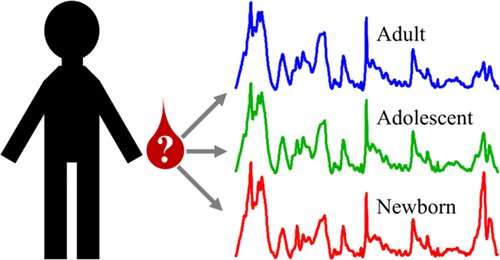Using bloodstains at crime scenes to determine age of a suspect or victim

From the spatter analysis made famous in the TV show Dexter to the frequent DNA profiling of CSI and the real cases covered in the FBI Files, blood tests are ubiquitous in forensic science. Now, researchers report in ACS Central Science that a new blood test, which could be performed at a crime scene, could help determine the age of a suspect or victim within just an hour.
Despite their usefulness, current blood tests that analyze samples from crime scenes have limitations. Many tests cannot be completed in the field, some take a long time, and others can destroy the sample. Typically, DNA and fingerprint analyses both require that the person of interest is included in a database. And even if the person's information is in a database, some characteristics like age cannot be determined by conventional DNA profiling or fingerprint analysis. To estimate age, one would ideally monitor something that changes over the course of a lifetime. Some components of blood (particularly the structure of hemoglobin that gives blood its characteristic red color) fit the bill. A technique called Raman spectroscopy provides information about the chemical composition and molecular structure of material. Thus, Igor Lednev and colleagues wanted to see whether they could use this method to analyze blood components to determine the ages of victims and suspects.
By performing Raman spectroscopy on samples from human donors, the researchers looked at samples from three different age groups: newborns (under one year), adolescents (approximately 11 to 13 years of age) or adults (43 to 68 years old). The researchers could distinguish between the groups—adolescent and adult samples were differentiated with greater than 99 percent accuracy, and there were no errors in the identifications of the newborn samples. Because the method is a non-destructive technique that requires no sample preparation, the authors say this could be a useful on-site addition to the current cohort of available tests. In the future, they plan to refine their model to provide more specific ages, not just large age ranges, of the donors.
More information: Kyle C. Doty et al. Differentiating Donor Age Groups Based on Raman Spectroscopy of Bloodstains for Forensic Purposes, ACS Central Science (2018). DOI: 10.1021/acscentsci.8b00198
Abstract
Developments in analytical chemistry technologies and portable instrumentation over the past decade have contributed significantly to a variety of applications ranging from point of care testing to industrial process control. In particular, Raman spectroscopy has advanced for analyzing various types of evidence for forensic purposes. Extracting phenotypic information (e.g., sex, race, age, etc.) from body fluid traces is highly desirable for criminal investigations. Identifying the chronological age (CA) of a blood donor can provide significant assistance to detectives. In this proof-of-concept study, Raman spectroscopy and chemometrics have been used to analyze blood from human donors, and differentiate between them based on their CA [i.e., newborns (CA of <1 year), adolescents (CA of 11–13 years), and adults (CA of 43–68 years)]. A support vector machines discriminant analysis (SVMDA) model was constructed, which demonstrated high accuracy in correctly predicting blood donors' age groups where the lowest cross-validated sensitivity and specificity values were 0.96 and 0.97, respectively. Overall, this preliminary study demonstrates the high selectivity of Raman spectroscopy for differentiating between blood donors based on their CA. The demonstrated capability completes our suite of phenotype profiling methodologies including the determination of sex and race. CA determination has particular importance since this characteristic cannot be determined through DNA profiling unlike sex and race. When completed, the developed methodology should allow for phenotype profiling based on dry traces of body fluids immediately at the scene of a crime. The availability of this information within the first few hours since the crime discovery could be invaluable for the investigation.
Journal information: ACS Central Science
Provided by American Chemical Society


















